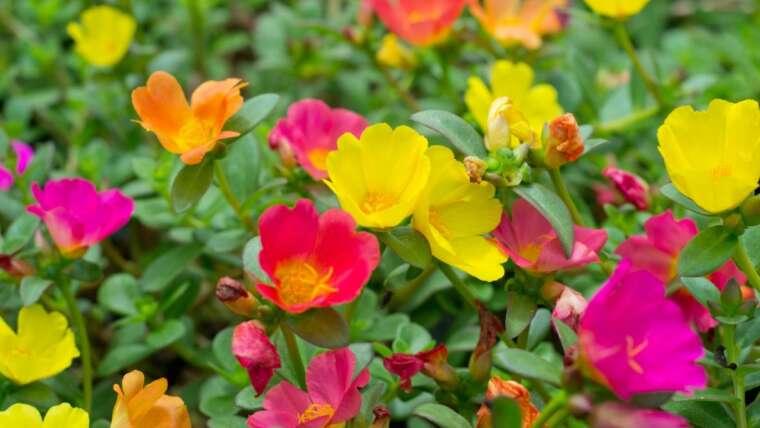An oft-repeated quote (author unknown) poses the question: When you see a field of dandelions, do you see a field of weeds or wishes? Whether thought of as a childhood favorite or the bane of suburban lawns, dandelions are the subject of much passionate debate.
Common dandelions (Taraxacum officinale), thought to originate in Europe, have become naturalized all over the world. These perennial flowers wake up in early spring and can live for up to 13 years. A single plant can produce thousands of seeds, with the ability to disperse 60+ miles away.
Originally brought to North America as a medicinal and nutritious edible herb, the common dandelion was purposely cultivated by early settlers as a food source. Named Dent de Lion (lion’s tooth) in French for the serrated leaves, the common dandelion also earned the nickname pissenlit (pee in the bed) for its rumored diuretic qualities.
But common dandelions are not the only species in the Taraxacum genus. There are likely thousands of Taraxacum species native to North America and Eurasia, all of which have similar properties. In fact, there’s an entire science devoted to their study – taraxacology!
So how did this cheerful yellow flower become so hated? In the 16th century, the nobility of England and France began cultivating lawns (though they were not always made of grass). Because only the rich could afford to make room for unproductive land, lawns became a status symbol. A short expanse of green around the home became a symbol of wealth that only those with leisure time could maintain.
After the trend reached the United States post-Civil War, it was a slow trend to take hold but eventually became a status symbol. Particularly in the post-depression 1940s and 1950s when it was part of the “perfect home” view portrayed in early television. During that period and into the 1960s, some chemical companies took on the task of encouraging Americans to keep anything but grass out of their lawns using lab-derived herbicidal methods. Dandelions, as the most persistent wildflower, eventually came to symbolize neglect, laziness, and even poverty.
If you despise dandelions, take the time to examine why. Is it because you find the yellow blooms ugly? Is it because years of cultural conditioning tell you that maintaining a manicured lawn is a sign of being a responsible citizen? In this article, we’ll look at the costs of fighting dandelions and whether or not it’s a war worth waging.
The Quick Answer
Many dandelion species are native to the United States, and the common dandelion is now naturalized in all 50 states. So the real question is whether or not the cost of fighting their presence in lawns is worth it.
The average American homeowner spends around $500 annually on lawn care, with national expenditures in the millions. Lawns use 30% of our limited water supply to maintain. On average, Americans with lawns spend 70 hours per year on upkeep. Lawns are a mono-crop with little ecological value other than as a ground cover.
Dandelions are food for pollinators, highly nutritious to humans, and good soil conditioners. Their deep taproots can reduce erosion, with some species growing taproots as deep as six feet underground. Dandelion leaves are consumed as green vegetables. Their flowers are used to make dandelion wine, and their roots can be roasted and ground as a coffee substitute. They are food for many moth species and other pollinators as well.
As so many species are native or naturalized in the United States, it’s impossible to eliminate dandelions completely. Even with herbicide use. Perpetuating the culture of pristine lawns in the style of French nobility may not be worth the price we’d pay to do it.
The Detailed Answer
Dandelions grow in disturbed soil, providing biodiversity and nourishment for various species.
Dandelions grow in disturbed soil, among plants with shallow root systems (like grass), and don’t take over native plant habitats or rangelands.
They are not on the USDA Federal Noxious Weed list. Although some Taraxacum species (particularly Taraxacum officinale) are considered invasive in Alaska and Oregon. Many species of dandelions are native to North America. For instance, Taraxacum californicum is an endangered dandelion species native to the San Bernardino mountains in southern California. Taraxacum ceratophorum is likely the most widespread native dandelion in the US. It is found mostly in the western half of the US.
Any flowers in a lawn improve biodiversity, potentially providing nourishment and shelter for a wide range of species. But in addition, dandelions can help pinpoint key things about our soil. Dandelions prefer disturbed soil that is rich in nitrogen and potassium but does not like high calcium or high phosphorus soils or soils where there is a lot of organic matter. This is valuable information to us as gardeners!
The Cost of Management
 The cost and ecological impact of eradicating dandelions is more significant than their worth in lawns.
The cost and ecological impact of eradicating dandelions is more significant than their worth in lawns.
More important than considering whether dandelions merit a place in our lawns is the logistical issue of how much it costs to try to maintain that perfect lawn instead of having the dandelions.
Americans collectively spend over 38 million hours and over 40 billion dollars on lawn care per year. Certain pesticides used in lawn grass (such as neonicotinoids) have contributed to the loss of an average of 1-2 million birds per year. Native songbird species are most at risk. Herbicides have less of a direct impact on the animal kingdom. Their use reduces access to essential food for many moth and pollinator species, creating a ripple effect through the wildlife food chain.
Nitrogen and phosphorus excess from lawn fertilizers can soak through the soil and end up in the water table as well as running off into the waterways, where it can spur the growth of invasive plants and algae that remove oxygen from the water, compete with native plant life, and harm fish. Polluted water tables become an issue for those who rely on well water for potable use, as well.
The typical lawn poses an incredible risk via the above elements to ecosystem management and creates problems that are very difficult to resolve. In comparison, seeing the occasional dandelion doesn’t seem all that bad!
How Do Dandelions Impact Pollinators and Wildlife?
 Dandelions serve as a valuable food source for various insects, birds, and animals.
Dandelions serve as a valuable food source for various insects, birds, and animals.
Native plant proponents tell us that dandelions are like junk food for bees and that North American native plants, like the prairie crocus, can provide more nutritious nectar during the same critical early-spring time period. I agree.
While I can seek out prairie crocus from a native nursery, they aren’t growing in my neighborhood. Should we put more effort into growing native plants? Absolutely. Do even imported dandelions, like the common dandelion, currently serve as an important early spring food source until we do? Yes.
Dandelions are a good food source for European honeybees and over 50 different insect species, including moths and butterflies. Songbirds like sparrows, indigo buntings, and American goldfinches eat their seeds. Hummingbirds use the fluffy pappus that the seedheads are attached to when they make their nests.
The leaves are eaten and enjoyed by rabbits, hedgehogs, turkeys, quail, chipmunks, and deer. Cattle and horses like them, too. And let’s not forget that while the greens are slightly bitter to our taste buds, many people relied on dandelion greens (and some still do) as a food source!
Dandelion Effect on Landscape
 Dandelions thrive in disturbed areas, acting as natural soil conditioners.
Dandelions thrive in disturbed areas, acting as natural soil conditioners.
Dandelions are not typically invading wilderness areas. Instead, they show up on sites disturbed by human impact or that is heavily grazed by livestock, where the soil is disturbed and a little wind-driven seed can find a new home.
Dandelions are actually natural soil conditioners. They’re called “earth nails” in China for their long tap roots, which can extend up to 6 feet deep into the soil to draw out nutrients and moisture, depending on the dandelion species. The roots break up compacted soil, provide aeration, and act as an erosion reducer in hill faces.
When dandelions decompose, the nutrients and minerals they’ve drawn from deep in the soil return to the soil, where they feed other plants. The living foliage shades the soil’s surface, conserving moisture. They prevent erosion from wind and water in areas that would otherwise be bare earth. In some countries, they’re used to attract pollinators to agricultural fields.
Aesthetics
 Dandelions, despite their aesthetic appeal, suffer from an image problem due to societal expectations of pristine lawns.
Dandelions, despite their aesthetic appeal, suffer from an image problem due to societal expectations of pristine lawns.
The other day, I drove by a gorgeous field blanketed in golden yellow. I drank in the sight, a welcome symbol of spring’s arrival in our cold, snowy climate. As I got closer, I realized the blanket of yellow was an enormous colony of dandelions. I had the same thought many would: did the owners not have the time or ability to maintain their field?
Why was the beauty of the field diminished by the knowledge that dandelions provided the color? Because they have an image problem.
Dandelions are aesthetically pleasing. They have fluffy, bright blooms. They look like sunshine in a field of green. We want to be rid of them because we’re taught that they symbolize neglect. Would they become more beautiful to us if we weren’t enculturated to believe that pristine lawns are standard?
Many other similarly-shaped flowers are popular in gardens. An excellent example is the Scabiosa genus of plants, often referred to as pincushion flowers. These are intentionally cultivated despite having a similar growth habit and flower shape. They also often have a “weedy” look to their foliage. If we reclaim the dandelion as a staple of the garden, it can continue to benefit the environment.
Advice for Dandelion Management
 Mow or remove dandelions without herbicides to maintain healthy soil.
Mow or remove dandelions without herbicides to maintain healthy soil.
You may feel pressured to keep a sterile and manicured lawn for fear of angering the neighbors or the HOA. After all, not everyone will see the “clocks” or seedheads of dandelions with the same delight as we all did as children. And you may want a cushion of nothing but grass because you like it – and that’s absolutely fine! You don’t have to let dandelions take over your lawn.
If you want to manage dandelions, mow them down with weeding tools, or pick them before they go to seed. This will prevent their multiplication in the short term. In the long term, the better solution is to remove the dandelion’s root system to take it out of your lawn. This is more effective, as the root system is necessary for these plants to come back in subsequent years.
Final Thoughts
It’s time to re-evaluate our feelings about dandelions. They are a beneficial food source for wildlife and pollinators and a potential ally against erosion. They teach us about our soil makeup and appear where soil disturbance has occurred. Meanwhile, we agonize while trying to eradicate them in the name of perfect lawns (comprised of non-native grasses) that serve no purpose other than maintaining the status quo.
Next time you see a fluffy white dandelion seedhead, go ahead and make a wish. Mine is that we’ll all wake up to how our actions impact the earth and learn to accept this little yellow wildflower.




